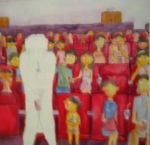 This book is a “Pinoy Primer” selected and edited by Neni Sta. Romana-Cruz. These are funny and heartwarming traits Filipinos are known for, wherever they are in the world. 🙂
This book is a “Pinoy Primer” selected and edited by Neni Sta. Romana-Cruz. These are funny and heartwarming traits Filipinos are known for, wherever they are in the world. 🙂
I wish I could put the entire book in this post but it will take too much time and effort, hehehe. You should get the book especially if you have foreign friends who seem to be baffled by your quirky habits.
Excerpts:
Family Matters – You know you’re Filipino if…
- You’re related to everyone.
- You have uncles and aunts named Boy, Girlie or Baby.
- You have relatives with the letter “h” slipped into their names, as in Jhun, Mhike, Bhen, and Sahmeeh. 😆
- You have relatives whose nicknames consist of repeated syllables, such as Jun-Jun, Ling-Ling and Mon-Mon. 😆
- The prospect of sending your elderly parents to a nursing home is inconceivable.
- You abide by your parents’ house rules even if you’re over 18.
- You live with your parents until – and at times even after – you’re married.
- You demand that your children sing and dance to amuse your friends and relatives.
Where We Live – You know you’re Filipino if…
- You decorate your living room wall with family’s framed diplomas, certificates and plaques.
- You decorate your dining room wall with a giant wooden spoon and fork and a picture of the Last Supper.
- You keep a Sto. Niño shrine in your living room.
- Your house has a “dirty” kitchen and a “clean” kitchen.
- You keep a tabo in your bathroom.
Health and Hygiene – You know you’re Filipino if…
- You shower at least once a day.
- You use a stone to scrub yourself in the shower.
- You prescribe ginger brew and salt mouthwash to treat sore throats.
The Way We Eat – You know you’re Filipino if…
- You eat with your hands.
- You eat more than three times a day.
- You think a meal is not a meal without rice.
- You don’t need a knife to cut your food.
- You think sandwiches are snacks, not meals.
- You feel compelled to greet anyone who sees you eating with the words “Let’s eat.”
- You swing your legs when you like the food.
- You like sweet spaghetti.
- You love “dirty” ice cream.
There… these are all I could write down at the moment. There’s plenty more where these came from. You can grab a copy at any National Bookstore outlet. It’s published by Tahanan Books. 😀








Readers’ Corner